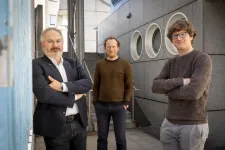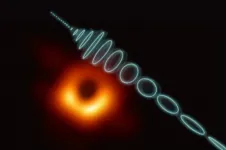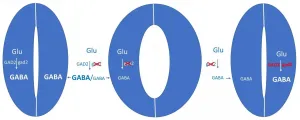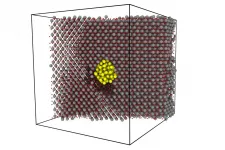(Press-News.org) Whether for microscopy, data storage or sensor technology, many advanced technological applications that require specific functions rely on the structure of the electromagnetic field near the surfaces of materials. In nanosystems, so-called surface phonons, i.e. temporal distortions of the atomic lattice, contribute decisively to the physical and thermodynamic properties.
If surface phonons could be specifically manipulated, it would be possible to achieve better thermal conduction or heat transfer between two components with nanosurfaces. This could be used, for example, in detectors, sensors or in highly efficient passive cooling systems. In addition, surface phonons concentrate electromagnetic energy spectrally into the far infra-red range. This paves the way for super-resolution lenses, improved vibrational spectroscopy or other fascinating applications.
Electromagnetic fields in the vicinity of nanostructures
Despite its enormous potential, this area of solid-state physics is still poorly explored. For the development of new nanotechnologies, these fields must first be made visible on the nanometre scale. "Visualizing these local fields is the starting point for a deeper understanding of the fundamentals and for better design of nanostructures," attests Gerald Kothleitner, head of the Institute of Electron Microscopy and Nanoanalysis at TU Graz. "Electron microscopes powerful enough to even register the relatively low energy of phonons were only developed a few years ago. To date, however, they could only be measured inadequately, at best in two dimensions."
First 3D imaging of surface phonons
Together with the French Laboratoire de Physique des Solides (LPS) Orsay, Gerald Kothleitner, his institute colleague Georg Haberfehlner and Ulrich Hohenester from the Institute of Physics at the University of Graz have now succeeded for the first time in imaging surface phonons in three dimensions. The results have been published in the Science journal.
Kothleitner, corresponding author of the study: "We excited these lattice vibrations with an electron beam, measured them with special spectroscopic methods, and then reconstructed them tomographically. As a result, the infra-red light fields generated by the surface phonons of a magnesium oxide nanocube became visible in three dimensions for the first time, and the spatial distribution was discernible. In particular, this also allowed us to image the sites with high field enhancements and the resulting strong interactions of certain phonons with the environment."
The development of the methodology and the implementation of the novel tomographic reconstruction were carried out under the leadership of the University of Graz. Ulrich Hohenester draws parallels between the familiar X-ray image and the computer tomography process: "A 3D reconstruction of the object can be created from many composite 2D projections." Instead of the X-ray beam, the physicists used an electron beam, which interacts with infra-red light fields instead of bones and tissue. "As on a violin or guitar," Hohenester explains, "the vibrations on the surface of the nanocube are broken down into a series of resonances. These modes are then chosen to obtain the best possible agreement with the experimental data."
Electron microscopic imaging techniques as a success factor
The first comprehensive evaluation and 3D representation of electromagnetic fields is a success that can be attributed to the close cooperation of TU Graz and the University of Graz in the framework of "NAWI Graz". A latest-generation scanning transmission electron microscope (STEM) was used to measure these radiation-matter interactions at the nanometre scale. There are only a handful of such microscopes in the world that allow this and one of them is in Orsay.
The concept of 3D imaging of phonons was developed by Gerald Kothleitner in collaboration with Orsay during project planning for a pan-European project called ESTEEM 3: a project in which, among other things, new electron microscopy techniques are being developed. In the field of applied electron energy loss spectroscopy and electron tomography, the researchers at TU Graz are among the world's leading working groups.
INFORMATION:
The work published in Science was done as part of an EU project on electron microscopy called "ESTEEM 3". The lead was shared between FELMI/TU Graz and LPS Orsay, with the measurements on cubic magnesium oxide nanoparticles in Orsay and the data analysis and 3D reconstruction within the expertise of FELMI. Theoretical foundations and simulation software for phonons were developed at the University of Graz within the framework of the FWF (Austrian Science Fund) project "Resonance modes of plasmonic nanoparticles".
This work is anchored in the Field of Expertise "Advanced Materials Science", one of the five strategic focus areas of TU Graz.
To the original paper:
Three-dimensional vectorial imaging of surface phonon polaritons. Xiaoyan Li, Georg Haberfehlner, Ulrich Hohenester, Odile Stephan, Gerald Kothleitner, Mathieu Kociak. Science, March 2021. Vol. 371, Issue 6536. DOI: 10.1126/science.abg0330
https://science.sciencemag.org/content/371/6536/1364/tab-article-info
A paper by the Kavli Institute for the Physics and Mathematics of the Universe (Kavli IPMU) Director Ooguri Hirosi and Project Researcher Matthew Dodelson on the string theoretical effects outside the black hole photon sphere has been selected for the "Editors' Suggestion" of the journal Physical Review D. Their paper was published on March 24, 2021.
In a quantum theory of point particles, a fundamental quantity is the correlation function, which measures the probability for a particle to propagate from one point to another. The correlation function develops singularities when the two points are connected by light-like trajectories. In a flat spacetime, there is such a unique trajectory, but when spacetime is curved, there ...
The recommendations are clear: physical activity is good for mental health. But it also depends on how varied it is. That's what a new study by researchers at the University of Basel shows, pointing to one of the reasons why well-being suffers during the pandemic.
A walk in the morning, a jog in the evening or even just going out to buy groceries: activity helps the psyche. Many are trying to stay active during the pandemic despite mandatory home office and limited leisure activities. Others find that they are moving significantly less than before the pandemic because previous everyday activities are off-limits due to measures taken against the spread of Covid-19.
Against this backdrop, a study led by Professor Andrew ...
A new type of universal computer memory - ULTRARAM™ - has taken a step closer towards development with a successful experiment by Lancaster physicists.
Professor Manus Hayne, who is leading the research, commented: "These new results confirm the astonishing properties of ULTRARAM™, allowing us to demonstrate its potential as a fast and efficient non-volatile memory with high-endurance."
Currently, the two main types of memory, dynamic RAM (DRAM) and flash, have complementary characteristics and roles:-
DRAM is fast, so used for active (working) memory but it is volatile, meaning that information is lost when power is removed. Indeed, DRAM continually ...
"I've been studying how plants regulate their water balance for over 35 years. To find a completely new and unexpected way for saving water has certainly been one of the most surprising discoveries in my life." So says Professor Rainer Hedrich, plant scientist and biophysicist from Julius-Maximilians-Universität (JMU) Würzburg in Bavaria, Germany.
Hedrich's group discovered this new strategy together with researchers from the University of Adelaide in Australia. The results have been published in the journal Nature Communications.
GABA quantity as stress memory
The publication shows: plants use the signalling molecule GABA (gamma-aminobutyric acid) to remember the dryness of a day. The drier it is, the ...
Applied physicists at the University of Sydney have proposed new standards to measure moisture leaks into bionic devices such as pacemakers, cochlear hearing implants and retinal replacements.
The researchers, who received an industry partnership funding through the Australian Research Council to undertake the study, say the new moisture standards could give the wearers of bionic implants extra confidence in the operation of the life-changing devices. They also say that the improved moisture-testing regime could be used in the emerging renewable energy industry where new-generation solar cells require high standards of humidity control.
Bionic implants must be able to operate successfully in moist environments ...
Scientists reported new research results today suggesting that artificial objects in orbit around the Earth are brightening night skies on our planet significantly more than previously understood.
The research, accepted for publication in Monthly Notices of the Royal Astronomical Society: Letters, finds that the number of objects orbiting Earth could elevate the overall brightness of the night sky by more than 10 percent above natural light levels across a large part of the planet. This would exceed a threshold that astronomers set over 40 years ago for considering a location "light polluted".
"Our primary motivation was to estimate the potential contribution to night sky brightness from external sources, such ...
A team of scientists led by Nanyang Technological University, Singapore (NTU Singapore) has developed a diagnostic test that can detect the virus that causes COVID-19 even after it has gone through mutations.
Called the VaNGuard (Variant Nucleotide Guard) test, it makes use of a gene-editing tool known as CRISPR, which is used widely in scientific research to alter DNA sequences and modify gene function in human cells under lab conditions, and more recently, in diagnostic applications.
Since viruses have the ability to evolve over time, a diagnostic test robust against potential mutations ...
Scientists at MIPT have found a possible explanation for the anomalously fast release of gas from nuclear fuel. Supercomputer simulations have uncovered an unexpected mechanism for accelerating the escape of gas bubbles from the uranium dioxide crystal matrix to the surface. The result points the way to eliminate the paradoxical discrepancy of several orders of magnitude between existing theoretical models and experimental results. The paper was published in the Journal of Nuclear Materials.
The diffusion of gas bubbles during reactor operation is one of the important topics in nuclear power relating to radiation safety. Bubbles of gaseous fission products (mainly xenon), accumulating in the fuel, affect many of its properties. Therefore, it is important, ...
Researchers at the University of Southampton have developed a new way of using nanomaterials to identify and enrich skeletal stem cells - a discovery which could eventually lead to new treatments for major bone fractures and the repair of lost or damaged bone.
Working together, a team of physicists, chemists and tissue engineering experts used specially designed gold nanoparticles to 'seek out' specific human bone stem cells - creating a fluorescent glow to reveal their presence among other types of cells and allow them to be isolated or 'enriched'.
The researchers concluded their new technique is simpler and quicker than other methods and up to 50-500 times more effective at enriching stem cells.
The study, led by Professor ...
The vast majority of the world's largest meat and dairy companies have not made an explicit commitment to achieving net-zero emissions by 2050, finds a new analysis by researchers at New York University.
The study, which appears in the journal Climatic Change, examines the climate impacts of the biggest 35 largest meat and dairy companies around the globe as well as their influence in shaping political responses to climate change.
It is the first peer-reviewed study to assess climate responsibilities of the largest meat and dairy companies.
"Large meat and dairy companies are not doing enough to tackle climate change, and countries are not doing enough in terms of holding them accountable," says Jennifer ...





